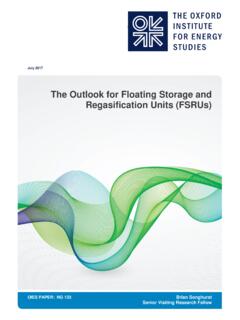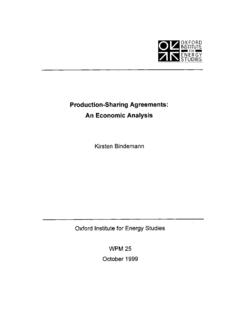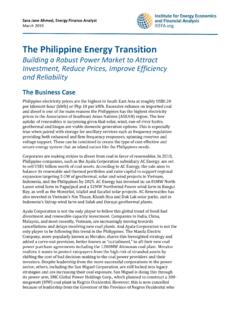Transcription of DECARBONIZATION PATHWAYS FOR OIL AND GAS CONTENTS
1 March 2020: ISSUE 121 DECARBONIZATION PATHWAYS FOR OIL AND GAS CONTENTS Introduction ..1 The role of carbon prices in the energy transition ..3 Jorge Blazquez, Spencer Dale, and Paul Jefferiss Justice in the Energy Raphael J. Heffron The oil and gas industry, low-emission PATHWAYS , and the energy transition ..9 Jim Herbertson An alternative energy transition pathway enabled by the oil and gas industry .. 14 Ahmad O. Al Khowaiter and Yasser M. Mufti Mechanics of the energy transition .. 20 Rob West CO2-enhanced oil recovery for DECARBONIZATION .. 23 Colin Ward Blue and Green Hydrogen in the Energy Transition.
2 26 D. Nathan MeehanDecarbonization of Gas .. 29 Martin Lambert Easy and economic solutions to mitigating methane emissions .. 31 Darcy Spady, Jackson Hegland Gaia oil and gas industry activists leading the way back inside planetary boundaries .. 35 Johana Dunlop 1 March 2020: ISSUE 121 OXFORD ENERGY FORUM INTRODUCTION The contraction in oil demand due to the spread of COVID-2019 and dissolution of the OPEC+ agreement in March have combined to generate shockwaves through the energy and financial markets. As governments all over the world grapple with one of the most severe economic crisis since the Global Financial Crisis and as the oil and gas industry is focusing on how to survive yet another extreme price cycle, some are of the view that climate change issues and DECARBONIZATION efforts will reduce in importance and may even fall off the agenda of some companies.
3 However, energy companies have a long-term horizon, their investments extend for multiple decades and the projects planned and delivered today will go through many cycles. Over these cycles, energy companies should not be distracted from the structural trends shaping the industry. The issue of transition and DECARBONIZATION will remain dominant, driven by environmental concerns, changes in public perceptions, investors attitudes, energy and climate policy, and the development of new technologies. In fact, one could argue that the current instability witnessed in oil markets and its underlying causes may render the oil and gas sector less attractive to investors and reinforce calls for an even faster transition from hydrocarbons.
4 The energy transition is a complex phenomenon and an inherently risky process, so its speed and trajectory are associated with high uncertainty. This is especially true when it comes to the core of traditional energies oil and gas. The oil and gas industry is considered the biggest part of the climate problem, as fossil fuels are responsible for the main share of greenhouse gas (GHG) emissions so oil and gas companies are already facing growing political, societal, and financial market pressures. At the same time, it could also become a part of the solution if the world finds PATHWAYS to accelerate DECARBONIZATION of oil and gas using new technologies and business models introducing new regulations and policies.
5 To meet energy demand, which is projected to continue to increase for the next few decades, making the best of the existing energy supply chain through DECARBONIZATION seems to be the most realistic and cost-effective option for the mid-term. This issue of the Forum is focused on the potential for transformations in the oil and gas industry during the energy transition and its dramatic DECARBONIZATION . It opens with an article by Jorge Blazquez, Spencer Dale, and Paul Jefferiss, who give a detailed argumentation that carbon prices can, and should, play a central role in driving the application of these technologies and alternative energy sources, providing incentives to everyone energy producers, consumers, investors, and financial markets to shift towards low-carbon technologies and activities.
6 This is a critical regulatory precondition for fast and massive DECARBONIZATION . The article proposes five principles to help guide future carbon pricing policies. The authors convincingly argue that carbon pricing is the most efficient policy tool for achieving the decisive shift in carbon emissions needed for the world to have a chance of hitting the Paris climate goals. Moreover, the revenues raised by carbon pricing can be used to help support a fair or just energy transition and, in so doing, help to increase the political and social acceptability of carbon pricing. This fundamental topic of justice in the energy transition is continued by Raphael Heffron, who shows that there is now an acceleration of justice in the energy sector.
7 He gives 10 key reasons why conditions have been created that are accelerating the concept of justice in the energy transition: new macroeconomic and regulatory trends, certain legal actions and supranational agreements (Paris Agreement, UN Sustainable Development Goals), penetration of personal technology, and the role of imagery. The energy industry can no longer afford to focus solely on profits but has to consider how new energy projects will result in just outcomes, in which considerations of social and environmental impacts are of vital importance alongside meeting new standards of commercial practice.
8 Justice in the energy transition is set to become the key influencer in government and business strategy and behaviour. According to the author, we are on the verge of a just transition to a low-carbon economy. Jim Herbertson looks at possible PATHWAYS to a low-emissions future, most of which share three common elements: improving efficiency and saving energy (the most cost-effective method of reducing GHG emissions); reducing emissions from power generation; and deploying alternative low-emission options in end-use sectors. In the power sector in the near term, one of the most cost-effective and impactful steps is to switch from coal to natural gas.
9 Longer term, the deployment of gas and biomass -based power generation with carbon capture and storage (CCS) would enable near-zero- or negative-emissions electricity. For the end-use sectors, alternatives include hydrogen, biofuels, industrial CCS, and bioenergy with CCS. CCS will likely be key for a transformation of the energy system; without large-scale commercial deployment of this technology, realizing a low-emissions pathway would be much more difficult and costly. The oil and gas industry can be an essential partner in this transformation of the energy system. The lowest-hanging fruit is reducing GHG emissions from the industry s own operations with a focus on energy efficiency and technological innovations in finding and producing oil and gas, which can not only reduce emissions but also produce energy savings.
10 The industry has also been taking action to reduce methane emissions and gas flaring both independently and in collaborative initiatives and voluntary industry groups. Another opportunity is helping consumers to reduce their emissions, including by replacement of higher GHG-emitting fuels with natural gas, improvement of 2 March 2020: ISSUE 121 OXFORD ENERGY FORUM vehicle engine design in ways that increase efficiency while lowering emissions, use of LNG for heavy-duty vehicles and ships, and use of advanced biofuels and hydrogen as energy carriers. These approaches have become mainstream in the energy transition discussion.












